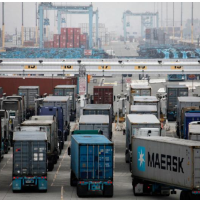Neighborhood Pollution Can't Stop Highway near Los Angeles Port
 Port of Los Angeles (photo: Nick Ut, Associated Press)
Port of Los Angeles (photo: Nick Ut, Associated Press)
Government planners of a new stretch of State Route 47 north from the Port of Los Angeles don’t have to consider its environmental effects on the neighborhood it runs past.
The U.S. Ninth Circuit Court of Appeals affirmed a lower-court decision last week that rejected a lawsuit by the Natural Resources Defense Council (NRDC) to block construction of the project, which would link the port directly to Interstate 405, until the welfare of the neighborhood was at least taken into consideration.
The three-judge panel said no. Federal law allowed the U.S. Department of Transportation, the California Department of Transportation (Caltrans) and the Alameda Corridor Transportation Authority to ignore the impact of pollution on the Wilmington neighborhood and just use a regional analysis.
That analysis was a winner, and a long-sought leg of the long-term plan to better funnel trucks into and out of the neighboring Los Angeles and Long Beach ports, which are expecting huge increases in business during the next decade, received a judicial blessing.
The ruling (pdf) affirmed a 2012 decision by U.S. District Judge John Kronstadt that the government agencies did not have to conduct a “hot spot analysis” on what effect more diesel-belching big-rigs would have on air quality and cancer rates in a neighborhood because broader studies indicated less traffic congestion in the region would be an environmental improvement.
The appellate court’s decision turned, in large part, on its interpretation of what the law meant by requiring pollution measures in “any area” of the project. The judges trotted out a copy of the New Oxford American Dictionary to determine that “any” may be pretty broad and inclusive and might lead one to believe that the neighborhood right next to the polluting freeway would reasonably be part of the study.
However, the court said “area” is a vague kind of word, “thus we are convinced that the statutory phrase ‘any area’ is ambiguous.” Too ambiguous to justify studying the health hazards of particulate matter pollution on the closest population.
No studies were needed to establish that the neighborhood was already a distressed community surrounded by an equally distressed series of neighborhoods that make up the Wilmington section of L.A. In addition to straddling the busiest port in the nation, 9.4-square-mile Wilmington is home to a lot of oil drilling, refineries and other industrial and chemical plants.
A quarter of the mostly Latino residents are poor, the crime rate is high, the education level is low and their environment is about as bad as it gets in L.A.
Richard Greene, an editorial writer at the Los Angeles Times, wrote in 2012, “Elected officials in far-off City Hall have found it convenient to view Wilmington as a freight yard or transportation corridor rather than a community of families living among the industrial goliaths.”
The courts, too.
–Ken Broder
To Learn More:
Greens Lose Battle over L.A. Port Highway (by Matt Reynolds, Courthouse News Service)
Transportation Project May Heighten Cancer Risk in Select Areas (by Louis Sahagun, Los Angeles Times)
Health Concerns Weighed against LA Highway Project (by Matt Reynolds, Courthouse News Service)
Council District 15: Wilmington and the Air That It Breathes (by Robert Greene, Los Angeles Times opinion)
Does It Smell Like This Where You Live? (by Jessica Lass, Natural Resources Defense Council)
Natural Resources Defense Council, Inc. v. U.S. Department of Transportation (U.S. Ninth Circuit Court of Appeals) (pdf)
- Top Stories
- Controversies
- Where is the Money Going?
- California and the Nation
- Appointments and Resignations
- Unusual News
- Latest News
- California Forbids U.S. Immigration Agents from Pretending to be Police
- California Lawmakers Urged to Strip “Self-Dealing” Tax Board of Its Duties
- Big Oil’s Grip on California
- Santa Cruz Police See Homeland Security Betrayal in Use of Gang Roundup as Cover for Immigration Raid
- Oil Companies Face Deadline to Stop Polluting California Groundwater





